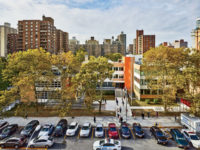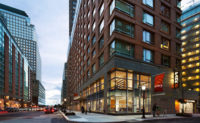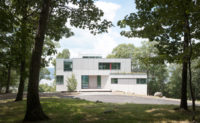Housing is in demand in Frankfurt-am-Main, yet loft living, or adapting obsolete manufacturing structures for open-plan residential use, remains a novelty, due in part to a dearth of century-old industrial buildings near the downtown area. But in 2009, when 1100 Architect was asked to convert the Lencoryt Building—formerly offices and a textile factory and now a historic monument—into dwellings, the designers felt a change was in order. “Some said lofts would not work, because this city is conservative,” says Gunter Weyrich, principal of the New York–based firm, which has a branch in Frankfurt, “but people are more open than many anticipated. And they think the site is thrilling.”
Additional Content:
Jump to credits & specifications
The east harbor district, where the project is located, has attracted artists and creative businesses. It includes a jumble of commercial and port-related enterprises sprawling north from Coop Himmelb(l)au’s new European Central Bank tower. Completed in 1913, the Lencoryt Building, with 60-foot-deep interiors and generous fenestration, is a rare surviving example of the city’s industrial architecture prior to World War II. Designed to be double its built size, it would have occupied the southwest corner of a block, with a long facade fronting the harbor. World War I intervened, and only the first phase, an L-shaped building facing a side street with a wing extending into a courtyard, was realized. Despite continuous use, its exterior was dilapidated and its once splendid lobby had been altered beyond recognition.
To convert it to residential use, a variance was obtained, and a second building, conforming to the planned 1913 footprint, was added. Together, the Lencoryt Building and the new one became the East Side Lofts. Although both have two vertical circulation cores servicing a below-grade garage, the Lencoryt features ground-floor offices, with studios and one-bedrooms on floors one to five, while the new section has shops below and units ranging from one-bedrooms to triplexes above. Duplex penthouses take up the remaining parts of floors five and six. Despite similarities, all involved—client, architect, and Frankfurt’s historic preservation office—felt that two distinct facade solutions were necessary.
“Because many of the Lencoryt Building’s facade elements had been lost, we wanted to bring it back to life” says Gerrit Heidenfelder, the local preservationist overseeing this project. Working from historical documents, the architects restored original details made from rust-toned sandstone and cast concrete, such as the three- and four-story-high Corinthian columns; reconstructed the slate-clad mansard roof; and repaired the lobby’s carved oak doors, mosaic floors, and smoke-toned marble walls. Only double-glazing was permitted for the deeply recessed windows, placed in rebuilt wood frames.
To harmonize between the two, the architects felt that the new facade, like the historic one, should also display similar plasticity and rhythm, without imitating the landmark design. Because it was closer to the harbor and round-the-clock activity, the new facade required additional thickness to accommodate sound insulation.
The architects arranged fiber-cement panels to create a faceted surface extending from the 93-foot-high roof ridge to the base. Adjacent to the Lencoryt Building, the triple-glazed fenestration duplicates the dimensions of the older building. Facing the harbor, it becomes more irregular to compensate for the shift in the building’s section. Platinum-gray diagonal bands are printed on some of the white panels, and when viewed from afar, they appear like horizontal folds casting elongated shadows across the surface.
According to Weyrich, a surprising number of older residents elected to live in the East Side Lofts because they desired an urban setting, although the ability to custom design one’s unit may have been appealing too. The lofts were sold as raw spaces; for additional fees, 1100 Architect adjusted plans to suit individual needs. As a result, almost all of the 88 units, ranging from 480 to 2,200 square feet and with interior ceiling heights from 10 to 13 feet, have unique layouts. Most at mid-section have 7-foot-deep balconies facing the courtyard, while the penthouses, some with 25-foot-high interiors, connect to roof terraces.
Two penthouse units, in the old and new sections respectively, displayed dove-toned, highly polished screed floors in combination with oak parquet, and kitchens (installed near the facade for natural illumination) that open onto continuous living-dining areas. The unit in the new section feels brighter, and the facade’s deep canary-yellow window jambs provide a warm contrast to the surrounding industrial landscape. The unit in the Lencoryt Building is dimmer, yet traces of the past, including the exposed wood roof truss, a restored fan window, and entry via the revived lobby, make for a cozier ambience.
Completed in 2015, the East Side Lofts not only brings variety to Frankfurt’s housing market, it enriches this urban landscape. Whereas the Lencoryt Building’s refurbished facade preserves historical memory, the new exterior, when glimpsed from the harbor edge, appears like a site-specific artwork or a giant sail shifting gently in the wind. “We don’t have graffiti problems with these buildings,” says Weyrich. “I guess people like them.”
CreditsArchitect: 1100 Architect — Juergen Riehm, partner in charge; David Piscuskas, partner; Susanne Milne, Gunter Weyrich, project managers Engineers: Ingenieurbüro P. & K. Toni (structural); Prof. Quick und Kollegen (civil); Ingenieurbüro Tegl (m/e); HEBO (acoustical) General contractor: BOP Gesellschaft für Bauoptimierung
Size: 160,000 square feet
Cost: $45 million
Completion date: March 2015 |
SpecificationsWood Windows and Doors Poetschke Tischlere
Metal Windows and Doors Schüco
Skylights Warema
Locksets FSB
Acoustical Ceilings Sto
Tile Mosa
Interior Ambient Lighting Foscarini
Exterior Lighting Bega
Elevators ThyssenKrupp
Custom Woodwork Heruday Schreinerei |















Post a comment to this article
Report Abusive Comment